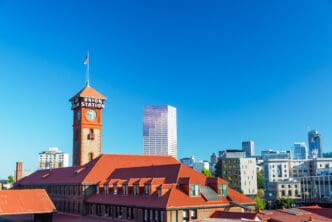Executive Summary
The Story So Far
Why This Matters
Who Thinks What?
President Donald Trump has intensified his focus on Portland, Oregon, during his second term, deploying federal officers and attempting to federalize the National Guard to address what his administration describes as “radical violence” and “out-of-control” protests. This escalation builds upon a sustained interest in the Pacific Northwest city that began during his first term, particularly around the Immigration and Customs Enforcement (ICE) facility, despite Portland not being among the largest cities by population or violent crime rates.
Continued Federal Action in Portland
The White House has justified its actions by citing instances of “rioters charged for crimes including arson and assaulting police officers” and claims of “Antifa militants” bringing a guillotine to the ICE facility. White House spokesperson Abigail Jackson stated that President Trump is “taking lawful action to protect federal law enforcement officers and address the out-of-control violence that local residents have complained about and Democrat leaders have failed to stop.”
This renewed attention to Portland comes as President Trump has also targeted other Democratic-led cities, including Chicago, Los Angeles, and Washington, D.C., with federal deployments for immigration enforcement and crime reduction. However, Portland’s inclusion stands out given its smaller size and recent declines in violent crime rates, according to the Real Time Crime Index.
Decades of Underlying Tensions
The roots of federal-local friction in Portland stretch back nearly a decade. Oregon has consistently voted for Democratic presidential candidates since 1984 and has maintained Democratic control of the governorship and state legislature for 12 consecutive years. Tung Yin, a professor at Portland’s Lewis & Clark Law School, suggested that Trump’s actions might be a form of “payback for the places that he didn’t do well in.”
Portland has a long-standing tradition of progressive politics and protest, from environmentalism to LGBTQ+ rights. The state of Oregon was the first in the country to declare itself a sanctuary for undocumented immigrants in 1987, a policy the Portland City Council adopted in 2017. The city is also recognized as an early home for cells of the decentralized “anti-fascist” movement, Antifa.
2016 and the First Term Escalation
Following Trump’s 2016 presidential election victory, protests erupted in Portland, prompting Trump to respond on X, calling them “Very unfair!” By the summer of 2018, demonstrations intensified outside the local ICE building, focusing on the administration’s policy of separating children from their parents at the border. Trump specifically named Portland in a letter, citing “repugnant hostility directed toward selfless ICE employees” from “anarchist protestors.”
In 2019, Trump issued a more direct warning, stating that “Portland is being watched very closely” and indicating he was considering designating Antifa an “ORGANIZATION OF TERROR.” Chris Shortell, a political science professor at Portland State University, noted that these early demonstrations “help set the stage for 2020,” marking a critical turning point.
The 2020 Flashpoint
The year 2020 became a flashpoint following the killing of George Floyd, which sparked nationwide protests. In Portland, thousands rallied for over 100 days, with daytime protests sometimes escalating into rioting and arson at night. Police frequently used tear gas and rubber bullets around the Multnomah County Justice Center and the Mark O. Hatfield Federal Courthouse.
Despite local leaders’ objections and without a formal request for assistance, Trump deployed over 700 officers from federal agencies to Portland, though he did not send the National Guard. This federal presence heightened tensions, leading to incidents such as federal agents beating a veteran and tear-gassing the mayor. A pro-Trump protester was fatally shot in August 2020, and Trump publicly celebrated when federally deputized law enforcement officers shot the suspected killer.
Local and state Democratic leaders strongly condemned the federal intervention. Then-Mayor Ted Wheeler told Trump to “stay the hell out of the way,” and then-Gov. Kate Brown called his actions “a blatant abuse of power.” Oregon’s attorney general and two U.S. House members subsequently sued the federal government, alleging violations of the 10th Amendment.
2025: A Persistent Focus
As Trump’s second term commenced, Portland remained a focal point. The Department of Education included Portland State University in its initial list of colleges to be probed over alleged antisemitism, placing it alongside elite institutions. Following renewed protests near the Portland ICE site this summer, Trump again labeled Portland “war-ravaged” and proceeded to designate Antifa a terrorist organization.
Unlike in 2020, when he pressed local leaders for military support, Trump in late September simply announced the federalization of 200 members of the Oregon National Guard, against local wishes. A Trump-appointed federal judge has since temporarily blocked this troop deployment to the city. Shortell noted that while Trump’s descriptions of Portland continue to evoke the images of violent 2020 protests, the current demonstrations are “so different.” Police reported 40 arrests through early Wednesday this summer, compared to over 500 in 2020, with current crowd sizes significantly smaller.
Given Trump’s consistent characterization of Portland, some local leaders and organizers suspect federal authorities may be attempting to provoke protesters. Senator Jeff Merkley, who previously introduced legislation to prevent federal forces from deploying in Portland, stated that Trump aims to “create the impression of chaos” to “justify more authoritarian power,” urging his constituents: “Don’t take the bait.”








